Iron Prince. Liberator of Siam and the legend of Thai boxing
This beautiful legend tells us about the heroic events of the distant XVI century. The name of Prince Naresuana is familiar to anyone who is interested. history Thailand (Siam) or was fond of such famous martial art as "Muay Thai" (Thai boxing). The medieval history of Siam is a history of constant confrontation with neighboring powers, primarily with Burma. In Indochina, Siam and Burma were constant rivals - like England and France in Europe. Two Buddhist countries have repeatedly fought with each other. The rivalry between Burma and Thailand was manifested not only in political history, but also in the same martial arts - suffice it to say that Burma has its own “Burmese boxing” - “letwhey”, characterized by even more stringent rules than Thai boxing. Naturally, the relationship between the two countries did not do without the constant clarification of whose fighters are stronger and whose martial art is more effective.
In the 16th century, a significant part of modern Thailand was occupied by the state of Ayutthaya, the direct predecessor of Siam. This state was created in the XIV century by the Thai tribes who supplanted the monks (Khmer-related people) that had dominated the Menam valley (now Chauphrai), which had dominated the valley before. The overwhelming majority of the population of Ayutthaya professed the Buddhism of the Hinayana direction (Little Chariot), but the system of government was built according to the Hindu principle - the monarch was considered a deity. In this, Ayutya inherited a tradition established by the ancient Khmer. In 1378, Ayutthaya took over another, more ancient Thai state, Sukhothai, and in 1438, Sukhothai finally merged into Ayutthaya. The next stage in the strengthening of Ayutthaya was the struggle against the northern neighbor - the Thai kingdom Lannatai. But, unlike Sukhothai, Lannaythai was able to maintain her independence, reflecting the onslaught of Ayutthaya.
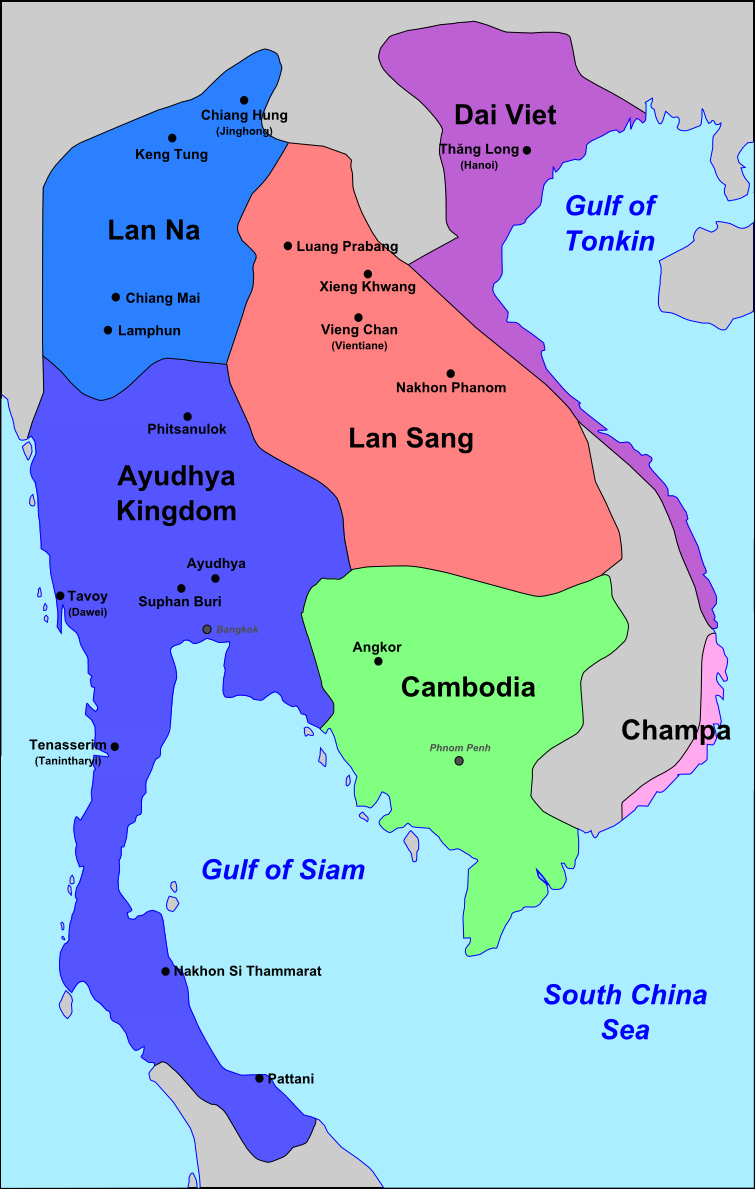
At the beginning of the 16th century, Ayutthaya began to develop economic relations with Portugal. In 1511, the Portuguese traveler Duarte Fernandez entered into diplomatic relations with Ayutia on behalf of the Portuguese crown. Cooperation with the Portuguese productively affected the development of military affairs. Several Portuguese travelers were recruited as instructors to the army of the Thai state. Thanks to the Portuguese, the first gunshot appeared in Ayutthaya weapon. King Prachai, who ruled 1534-1546, made an unsuccessful attempt to conquer the state of Lannay again. However, the military defeat led to an aggravation of intrigues and contradictions at the royal court. Maha Chakrapat, who reigned until 1549, came to power in Ayutthaya in 1569.
At this time, taking advantage of the internecine strife in Ayutthia, the powerful neighbor of the country, the Burmese kingdom (Tangu), decided to intervene. The strengthening of the Burmese state took place in parallel with the strengthening of Ayutthaya. In 1510, Prince Mingginieu (1486-1531) built the new city of Taungu, which soon became the capital of the state, around which the unification of the Burmese lands took place. The further formation of the Burmese kingdom took place during the next king, Tabinshvethi (1531 — 1551). In 1541, the troops of Taungu captured the capital of the Mensk kingdom of Hantavadi, Pegu, to which the capital of Burma was soon transferred. Having finished with the independence of the monks, Tabinshvethi laid eyes on neighboring Ayyutia, since at that time the latter had suffered a serious setback in the war with the state of Lannaythai and was weakened by internal strife. The Tanguu forces invaded Ayutthia. The Siamese army was defeated in a fierce battle on the elephants that occurred on the border of the country. The situation was corrected only by the timely arrival of reinforcements led by the governor of Sukhothai, which was able to repel the attack of the Burmese. After that, King Tabinshvethi decided to temporarily move away from public affairs, but in 1551, he was killed by rebel monks. This circumstance, which, on the contrary, seemed to strengthen the position of neighboring Ayutthaya, in fact led to extremely negative consequences for the Siamese state.
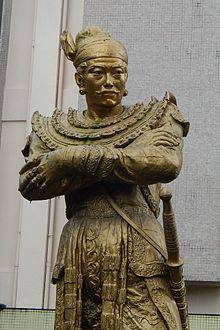
Bayinnaun (1516-1581), who was brought by her husband to the half-sister of the deceased king Tabinshvetha, ascended the throne of Burma. Bayinnaun (in the photo - a monument to this king) was a militant and ambitious man. He embarked on a massive strengthening of the Burmese state and the expansion of its borders. In 1557, Bayinnaun was even able to subdue the belligerent Shan principalities in the Shan mountains, eliminating the threat of constant raids of the Highlanders — Shan to the Burmese lands. After that, Bayinnaunu managed to create a huge empire, the like of which did not know the history of Indochina. The state of Taungu in his reign included most of Burma (present-day Myanmar), Manipur (now the state of India), Mon-Shan (southern districts of modern Chinese Yunnan province), the Principality of Lansang (the territory of modern Laos), the land of warlike Cook tribes in northeastern Burma, and proper Ayutthaya. According to Buddhist tradition, Bayinnaun was proclaimed a “chakravartin” - the ideal ruler who eliminated chaos and brought society back to order. According to Buddhist teachings, the arrival of chakravartina marks the beginning of a new era. Actually, for the Burmese state, Bayinnaun’s rule was the starting point for its further development.
In 1558, Bayinnaun captured the kingdom of Lannathi, located between Burma and Ayutthaya. Unlike the Ayuttai troops, who could not previously conquer this country, the Burmese army managed to defeat the defenders of Lannaytha. Further in the plans of the Burmese king was the capture of Siam. In 1563, the Burmese troops were transferred to the border with neighboring Ayutthaya, but the authorities of the latter were able to pay off a large tribute from Bayinnaun. When King Ayutthaya Maha Chakrapat passed away in 1568, the Burmese king decided that it was time to act. The troops of the state of Taungu approached the capital of Ayutthaya. In 1569, the new king Ayutthy Pra Mahin was forced to capitulate and surrender the capital to the Burmese. By the age of fifteen, Ayutia was a vassal of Burma.
In the same year 1569, Maha Thammaracha, crowned as King Sanphat I, was appointed ruler of Ayutthaya. So that Sanphat I retained loyalty to the Burmese crown, King Bayinnaun ordered the fourteen-year-old sons of the new King Ayyutia to be held hostage. So princes Naresuan and Ekathotsarot appeared in Burma. As befits the offspring of the royal family, they were settled in the palace and began to teach martial art. At that time, Burmese military was considered the best in Indochina. Under the guidance of experienced mentors, the young men mastered all the military wisdom, including the art of hand-to-hand combat.
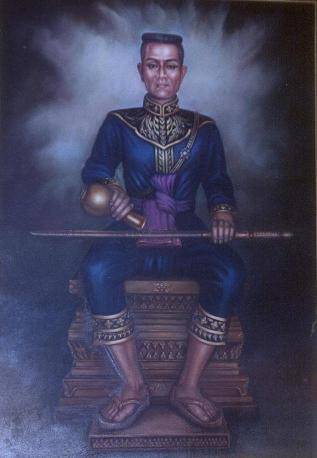 In 1571, sixteen-year-old Naresuan (pictured) was allowed to return to Ayutthaya - by this time the Burmese king was convinced of the loyalty of Sanphat I. The young Siamese prince was appointed by his father as governor of Phitsanulok province in the north of the state, where, by the way, Naresuan was born sixteen years earlier in 1555 year. Being the governor of the province, Naresuan carried out direct command of the Siamese troops who at that time fought with neighboring Cambodia. Having won several victories over the Khmer army, Naresuan, however, was puzzled by the questions of combat training of Siamese soldiers. He managed to notice that the Siamese army is significantly inferior to the Burmese in quality training. Therefore, the prince began to prepare the soldiers of Ayutthaya according to the Burmese canons, which he had learned during the "honorable captivity" in Taungu. This paid off - already in 1575, the troops under the command of Naresuan inflicted a serious defeat on the Khmer army, which threatened the capital of the country.
In 1571, sixteen-year-old Naresuan (pictured) was allowed to return to Ayutthaya - by this time the Burmese king was convinced of the loyalty of Sanphat I. The young Siamese prince was appointed by his father as governor of Phitsanulok province in the north of the state, where, by the way, Naresuan was born sixteen years earlier in 1555 year. Being the governor of the province, Naresuan carried out direct command of the Siamese troops who at that time fought with neighboring Cambodia. Having won several victories over the Khmer army, Naresuan, however, was puzzled by the questions of combat training of Siamese soldiers. He managed to notice that the Siamese army is significantly inferior to the Burmese in quality training. Therefore, the prince began to prepare the soldiers of Ayutthaya according to the Burmese canons, which he had learned during the "honorable captivity" in Taungu. This paid off - already in 1575, the troops under the command of Naresuan inflicted a serious defeat on the Khmer army, which threatened the capital of the country. In 1584, Naresuan completed the retraining and rearmament of the Siamese army. At the same time, the construction of defensive structures was completed. After that, it was possible to get rid of vassal dependence on Burma by the Siamese. Moreover, even in 1581, King Baiinnaun died, and his son Nandabayn, who ascended the throne of Burmese, did not have the outstanding potential of his predecessor.
With the consent of his father King Sanphat I, Prince Naresuan announced that Ayutia was no longer a vassal of the Burmese crown. The answer came immediately. Burma troops invaded Ayutthaya. However, Naresuan, who commanded the Siamese army, wanting to avoid direct confrontation with a stronger opponent, began a guerrilla war. Siamese troops destroyed the fields and led away the cattle, leaving the Burmese "scorched earth." In the end, the Burmese troops retreated from the territory of Ayutthaya.
- monument to Naresuan in Lampang
In 1586, Naresuan realized the long-standing dream of the Ayutan kings — he conquered and conquered the kingdom of Lannay with its capital in Chiang Mai. Since this state was located directly between Siam and Burma, now the borders of the two ambitious Indochinese powers touched. The Burmese troops again tried to invade the territory of Ayutthaya, but the attack was repulsed by the Siamese army. In 1590, King Ayuttha Sanphat I passed away. Although Naresuan was the de facto ruler of the state by this time, it was necessary to formally take the throne. The prince was crowned under the name Sanphat II. In 1591, the troops of Burma again attempted to invade Ayutthaya. On the territory of the modern province Suphanburi (central part of Thailand), near the village of Nomg Saray, there was a grand battle of the Burmese and Siamese armies. It was here that Naresuan challenged and killed the heir to the Burmese throne, Prince Min Chit Sva, after which the Burmese army was forced to retreat.
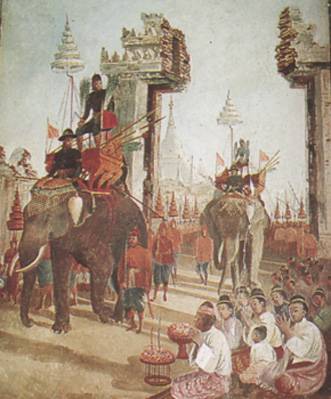
The battle of Naresuana and Min Chit Sva became a landmark event for the history of not only Siam, but the whole of Indochina. It is not by chance that Naresuan is revered in Thailand as the greatest figure in national history. After the Burmese army was defeated and left the borders of Siam, Naresuan did not stop - now it was Ayutthaya’s turn to take revenge. Already in 1593, Ayutthaya conquered the Tenasserim, a vast province on the Andaman Sea (today it is Tanintaya province in Myanmar), then the Mergui Archipelago (now Myayi Island, also in Myanmar). The power of Ayutthaya spread to Tavoy, a city and region in the Tenasserim, inhabited by monks and Karen. The Burmese king was unable to resist the Siamese army. Burma has ceased to be a serious opponent for Ayutthaya. After that, Naresuan, convinced of the absence of the Burmese threat, turned his eyes to the east. There was another eternal opponent of Siam - the Khmer kingdom of Cambodia. In 1593, Siamese troops invaded Cambodia. The one hundred thousandth Thai army inflicted a crushing defeat on the Khmer, after which the Cambodian king was forced to flee with his court to the territory of Laos. Thus ended the long and majestic history of the Khmer Power, which was no longer able to recover from the defeat inflicted by Naresuan. Cambodia has lost the status of a regional power. Burma in 1599 year, after King Nandabayn was captured by the rebels of Arakan, and the capital of the country burned, again disintegrated into several feudal states. Thus, Ayutia (Siam) became the only powerful state in Central and Western Indochina.
During the reign of Naresuana, Siam reached its greatest size in its history, which was directly promoted by the aggressive policy of the head of state. The composition of the Siamese state included numerous territories of modern Myanmar, Cambodia and Laos. At the same time, Naresuan continued to strengthen the defense capacity of the state, developing relations with European states. In 1598, Ayutthaya established diplomatic relations with Spain. However, 25 on April 1605, Naresuan passed away - he was on a military campaign in the Muang Hang area on the border with Burma. The circumstances of his death are unknown to the end. So, some historians claim that the fifty-year-old king was killed in battle, others that he died of smallpox. Since Naresuan left no heirs, the throne of Ayutthaya passed to his brother Ekhotsarotu, who was crowned to the throne under the name of Sanphat III.
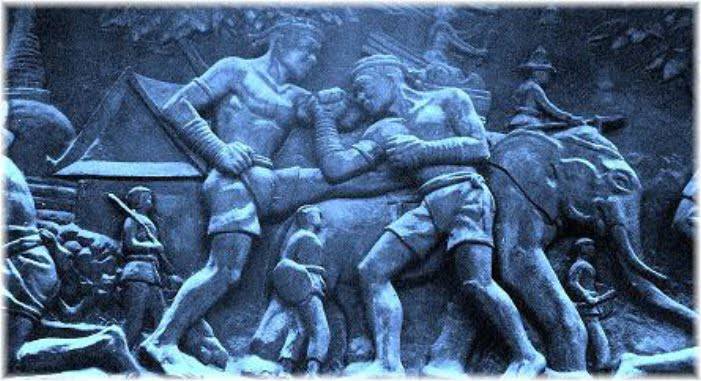
In the history of Thailand, Naresuan forever remained not only as a ruler who achieved the return of the country's independence and as the creator of a huge empire, but also as one of the greatest martial arts masters. Received a military education in Burma, Naresuan introduced the most modern at that time methods of military training Indochinese armies in the practice of training Siamese soldiers. It was during the reign of Naresuana that unarmed unarmed combat entered the system of mandatory training of the Siamese army. The best fighters got the opportunity to move from the army units to the guard, and even become the personal bodyguards of the Siamese king. In the tradition of Muay Thai, Prince Naresuan is revered as the actual founder of this martial art.
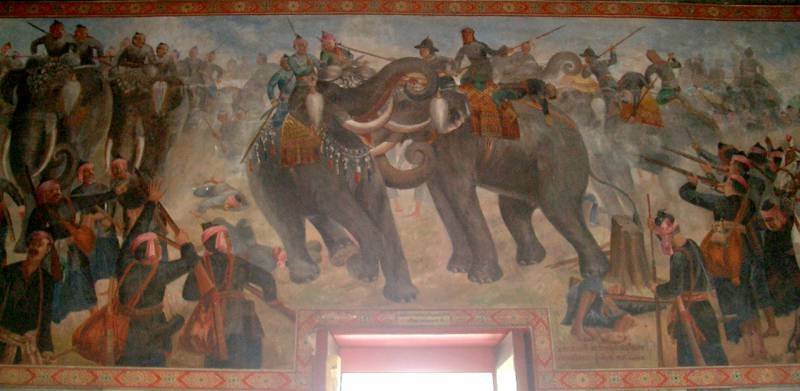
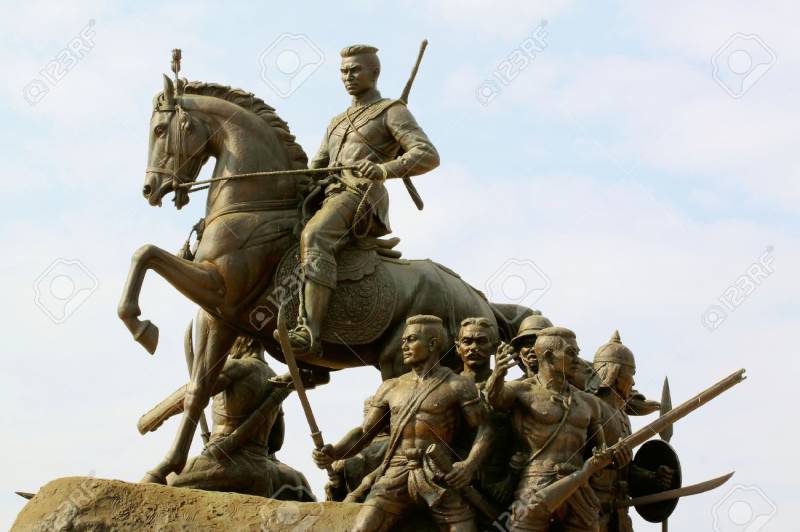
Information